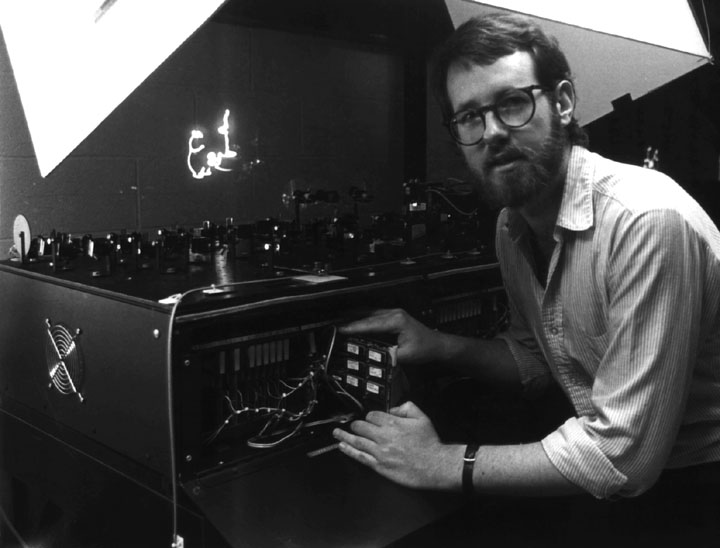Zap Animation Program
 Stone Mountain Park, Georgia - May 1983 |
|
Here I am installing a (64K byte) EPROM board into one of the two ZAP computers in Stone Mountain Park, Georgia. The 24 slot card cages were built into the laser projectors. The projector was installed in a glass room that lifts out of the ground for the nightly LASER show. This was a great arraignment, as you can test the lasers during the day (see the poo bear animation in the background.) The funny thing about this photo is that its the smallest image I ever saw the lasers make, yet when the glass room rises it projects the biggest digital image that I know about, some 3,000 feet wide (not counting the fireworks.)
I wrote the whole software system for LaserMedia. This included: —> TOP, the graphic digitizing program, a mixture of Z80-assembler and FORTRAN ZAP was written in a very object oriented style, although I did not know what was meant by object oriented programming until the late 80's. Within ZAP was the display routines which outputted a point every 70 microseconds (14,285 time a second), in an interrupt process took about 70% of the CPU. The other 30% of the CPU was used to handle real time request from the ASCII terminal, updating the display of the ASCII terminal, interpreting what we called level 2 commands, and running compiled level-3 code. I added an ability to display real time text from an installed font, it was called Word-Fire. The whole system ran from EPROM (plus 8K RAM). This was a great feature, as in rock 'n roll concerts, the way things get fixed is to kick it and hit reset. It only took about 3 or 4 seconds for ZAP to come back up again, and that delay was due to the time to update the ASCII screen over the 9.6K baud serial link. I also added a level-4 interface, which was simply connecting level-3 programs in the one hit function keys. We added to the program as needed, features such as a host / multiple slave communication, audio time code (my home brew version), relay output / input synchronizing, fireworks ignition control, etc. We also added battery backed RAM for saving level-2 programming. EPROMs Tricks EPCOT Both systems are still running 16 years later, and I am under the impression LaserMedia continued to sell ZAP up until the end, 2000. (see lasermedia.com) |